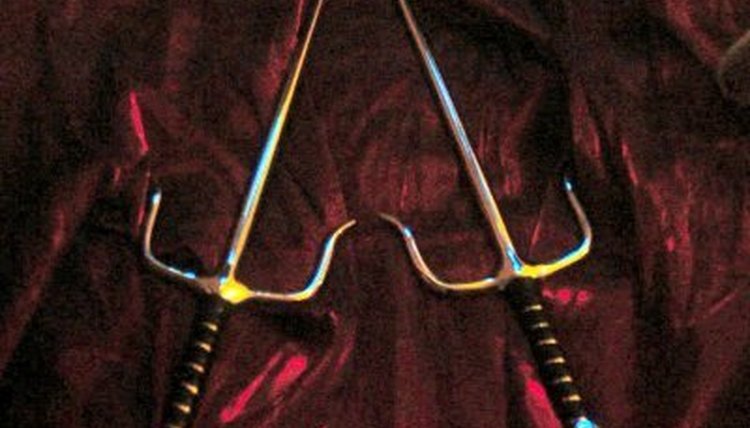How to Use a Sai Weapon

Although credit for the invention of the Sai is commonly given to Okinawa, the origins of the weapon can actually be traced back to Indonesia and Malaysia. The weapon later spread to India, China, Japan and Thailand. Although not very effective as an offensive weapon, the Sai was a nearly perfect defensive weapon, particularly in an era when most fighting was done with staffs or swords. The Sai, normally used in pairs with one in each hand, could easily block blows and disarm opponents. If you have ever been curious about how to use this ancient weapon, keep reading to learn how to use a Sai weapon.
How to Use a Sai Weapon
Grip the Sai properly. The ideal method of gripping your Sai is to wrap your four fingers around the handle, and to place your thumb at the top of the handle, at the spot where the handle and the center blade meet. The grip puts your hand in a position similar to making a thumbs up symbol. This is ideal because it makes it fast and easy to transition your grip from one where you are holding the Sai upright to one where you hold it down, as a guard running along the under side of your forearm.
Block your opponents attack. As your opponent attempts to strike with his staff weapon, spin the Sai in your dominant hand around. This will be the Sai in your right hand if you are right-handed, or the one in your left hand if you are left-handed. If you are using the grip described in Step 1, it should be easy to turn the Sai so that you are holding the handle in your palm, with the central blade of the Sai running the full length of the under side of your elbow. In this manner, the Sai acts almost like an exoskeleton, allowing you to block the blow without damaging your bone or muscle, since the blow only comes into direct contact with the hard steel of the Sai blade.
Hook the weapon. Once your opponent’s strike has been blocked, slide one of the outside prongs (called yoku) over the staff, so that the staff is wedged between the yoku and the center blade. You may also want to give the Sai a slight twist just to strengthen the binding effect of your grip on the staff. You have now hooked the weapon to prevent your opponent from being able to retract the staff in preparation for another blow.
Disarm your opponent. With the Sai in your dominant hand keeping the staff under control, use the Sai in your other hand to do a straight up thrust in the area of your opponent’s wrist or lower forearm. The idea is that the Sai will hook the flesh or the clothing and break your opponent’s grip so that you can move the arm away from the staff and disarm them. This is a dangerous move that can cause serious injury, so unless you are in a combat scenario, you should only practice this move slowly and with light force.
Finish off your opponent. Once your opponent’s grip on the staff has been neutralized, return to the Sai in your dominant hand. Unhook the grip on the staff, and using the butt end of the Sai, thrust the weapon into the opponent’s forehead. This is more than enough to knock them unconscious. During combat situations, it is also common to thrust the butt end of the Sai into the solar plexus, but this move can be lethal and should be practiced with delicate care. In extreme combat scenarios, one may also opt to thrust the central blade into an enemy. The edge of the blade is not sharpened, but the tip does come to a point that can penetrate human flesh.
Tips
Always practice with slow movements. Remember, you’re dealing with a deadly weapon here, and you do not wish to really cause physical injury to your sparring partner.
Warnings
The Sai can be lethal or cause serious bodily injury. Beginners should only train with a Sai under the guidance and supervision of a mentor with exceptional experience using this weapon.
Tips
- Always practice with slow movements. Remember, you’re dealing with a deadly weapon here, and you do not wish to really cause physical injury to your sparring partner.
Warnings
- The Sai can be lethal or cause serious bodily injury. Beginners should only train with a Sai under the guidance and supervision of a mentor with exceptional experience using this weapon.
Writer Bio
Jerry Garner has been writing semi-professionally for more than 15 years. The body of Garner's work includes informative articles, news and current events and historical essays. He is an avid sports fan and frequently writes about outdoor activities online.
